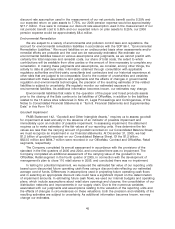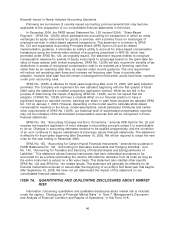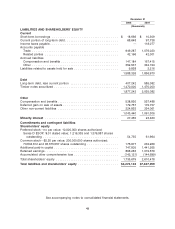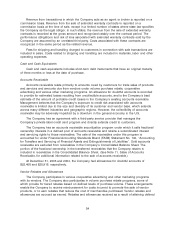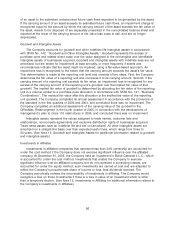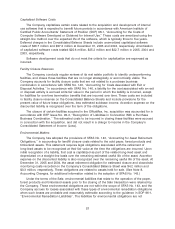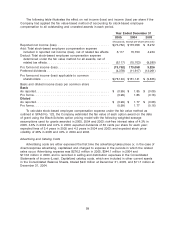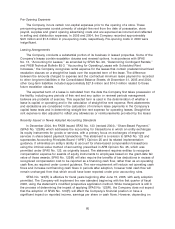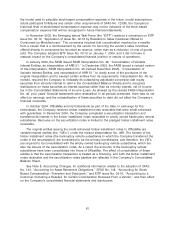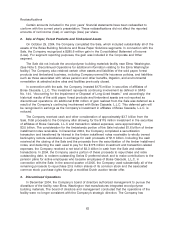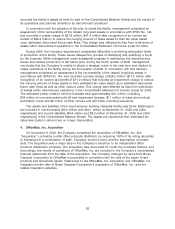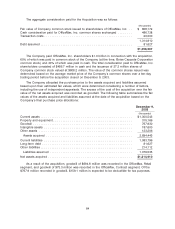OfficeMax 2005 Annual Report Download - page 59
Download and view the complete annual report
Please find page 59 of the 2005 OfficeMax annual report below. You can navigate through the pages in the report by either clicking on the pages listed below, or by using the keyword search tool below to find specific information within the annual report.purchase levels are accrued over the incentive period based on the terms of the vendor
arrangement and estimates of qualifying purchases during the rebate program period. These
estimates are reviewed on a quarterly basis and adjusted for changes in anticipated product sales
and expected purchase levels. Volume-based rebates and allowances earned are initially recorded
as a reduction in the cost of merchandise inventories and are included in operations (as a
reduction in materials, labor and other operating expenses) in the period the related product is
sold. Amounts received under other promotional programs are generally event-based and are
recognized at the time of the event as a reduction of cost of goods sold or inventory, as
appropriate, based on the nature of the promotion and the terms of the vendor agreement.
Advertising and other allowances that represent reimbursements of specific, incremental and
identifiable costs incurred to promote vendors’ products are recorded as a reduction of selling and
distribution expenses in the period the expense is incurred.
Effective January 1, 2003, the Company adopted the guidelines issued by the FASB’s
Emerging Issues Task Force (the ‘‘EITF’’) in Issue No. 02-16, ‘‘Accounting by a Customer (Including
a Reseller) for Certain Consideration Received From a Vendor.’’ (See Note 8, Accounting Changes,
for information related to the 2003 accounting change for vendor allowances.)
Merchandise Inventories
Inventories consist of office products merchandise and are stated at the lower of weighted
average cost or net realizable value. The Company estimates the realizable value of inventory using
assumptions about future demand, market conditions and product obsolescence. If the estimated
realizable value is less than cost, the inventory value is reduced to its estimated realizable value.
Throughout the year, the Company performs physical inventory counts at all locations. For
periods subsequent to each location’s last physical inventory count, an allowance for estimated
shrinkage is provided based on historical shrink results and current business trends.
Property and Equipment
Property and equipment are recorded at cost. Cost includes expenditures for major
improvements and replacements and the net amount of construction period interest cost associated
with significant capital additions. Capitalized interest was not significant in any of the periods
presented. Gains and losses from sales and retirements of property and equipment are included in
other (income) expense, net as they occur.
The Company calculates depreciation using the straight-line method over the estimated useful
lives of the assets or the terms of the related leases. The estimated useful lives of depreciable
assets are generally as follows: building and improvements, 5 to 40 years; furniture and equipment,
1.5 to 5 years; and machinery, equipment and delivery trucks, 5 to 10 years. Leasehold
improvements are amortized over the lesser of the term of the lease, including any option periods
that management believes are probable of exercise, or the estimated lives of the improvements,
which generally range from 5 to 15 years. Depreciation on assets used in the Company’s sold
paper and forest products operations was determined using either the straight-line method or a
units-of-production method that approximated straight-line over three to five years.
Long-Lived Asset Impairment
In accordance with SFAS No. 144, ‘‘Accounting for the Impairment or Disposal of Long-Lived
Assets,’’ long-lived assets, such as property, plant, and equipment, capitalized software costs and
purchased intangibles subject to amortization, are reviewed for impairment whenever events or
changes in circumstances indicate that the carrying amount of an asset may not be recoverable.
Recoverability of assets to be held and used is measured by a comparison of the carrying amount
55


